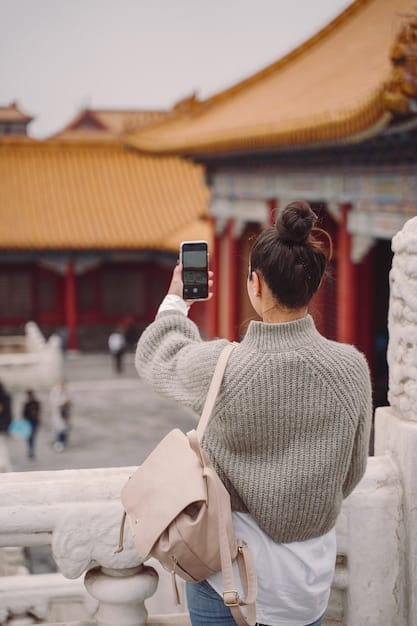Japan’s Internet Access Guide: Stay Connected as a US Traveler

Japan’s Internet Access Guide: Staying Connected as a US Traveler provides essential information for US travelers on navigating internet options in Japan, including pocket Wi-Fi rental, SIM cards, public Wi-Fi, and understanding costs and practical considerations for seamless connectivity.
Planning a trip to Japan as a US traveler? Staying connected is crucial, whether for navigating bustling city streets, sharing breathtaking sights, or keeping in touch with loved ones back home. This Japan’s Internet Access Guide: Staying Connected as a US Traveler breaks down everything you need to know to ensure a smooth and connected journey.
Understanding Your Internet Needs in Japan
Before diving into the options, let’s consider what your connectivity needs might be during your trip to Japan. Think about how much you plan to use the internet for things like maps, social media, video calls, and work. This will help you determine the best and most cost-effective solution for staying online.
Data Usage Considerations
Consider what kind of data usage you will use during our trip. Checking emails and using maps requires less data, while streaming videos and making video calls uses more.
- Occasional Use: If you primarily need internet for basic communication, checking emails, and using maps occasionally, a smaller data plan might suffice.
- Moderate Use: For social media, some streaming, and frequent map use, a medium-sized data plan is a good choice.
- Heavy Use: If you plan to stream videos, make frequent video calls, or use data-intensive apps, opt for a larger data plan or unlimited option.
Assessing Your Devices
The number of devices you plan to connect to the internet will also help you determine the best service. Connecting multiple devices for you and your family may require you to seek out a pocket wifi.
Whether you use tablets, smartphones, laptops, and other devices, you will need to keep in mind connecting these devices when planning your connectivity to make sure you are not caught off guard during your vacation.
In conclusion, understanding your internet needs in Japan and assessing your devices will ensure you choose a right option to stay connected with ease.

Pocket Wi-Fi Rental: A Popular Choice
One of the most popular and convenient options for internet access in Japan is renting a pocket Wi-Fi device. A pocket Wi-Fi is a portable router that creates a Wi-Fi hotspot, allowing you to connect multiple devices simultaneously.
Benefits of Pocket Wi-Fi
Pocket Wi-Fi offers several advantages, including fast and reliable internet, ease of use, and the ability to connect multiple devices. It’s convenient to carry around and provides a secure connection compared to public Wi-Fi hotspots.
- Fast Internet Speed: Pocket Wi-Fi devices in Japan typically offer 4G LTE or even 5G speeds. This is more than enough for streaming, video calls, and heavy web browsing.
- Connect Multiple Devices: Pocket Wi-Fi allows connecting up to 5-10 devices simultaneously, which is ideal for families or groups traveling together.
- Reliable Connection: Unlike public Wi-Fi, pocket Wi-Fi provides a more stable and secure connection.
Where to Rent a Pocket Wi-Fi
You can rent a pocket Wi-Fi device online before your trip or upon arrival at major Japanese airports like Narita (NRT) and Haneda (HND). Major providers include Japan Wireless, Sakura Mobile, and Pupuru WiFi. Be sure to compare prices, data allowances, and rental periods.
Be sure to book ahead of time or ensure plenty of time to reserve and pick up the pocket Wi-Fi device at the airport location.
Overall, pocket Wi-Fi rental in Japan is a worthwhile solution to consider, especially if you are traveling with a family or group and would like a reliable internet service.
Using a Japanese SIM Card
Another popular option for staying connected in Japan is using a Japanese SIM card. Swapping out your US SIM card for a local one gives you access to Japanese mobile networks, providing data and sometimes voice services.
Types of SIM Cards Available
There are two main types of SIM cards available for tourists in Japan: data-only SIMs and SIMs with voice services. Data-only SIMs are more common and affordable, suitable for most travelers who primarily need the internet.
Consider which type you may purchase based on your personal plans. If you primarily use messaging apps and email, a data-only SIM may be right for you, but if your job depends on phone calls, you may want to consider looking into one that can offer voice services.
Purchasing and Activating a SIM Card
You can purchase a Japanese SIM card online, at major airports, or at electronics retailers like Bic Camera and Yodobashi Camera. Activation usually involves following the instructions provided with the SIM card, which may require setting up APN (Access Point Name) settings on your phone.
Be sure that the SIM card you are planning to purchase covers the length of your trip so you are not caught stranded without cell service at the end of your trip.
In summary, using a Japanese SIM card is a fantastic alternative that is convenient in staying connected wherever you may go.
Free Public Wi-Fi Hotspots
Free public Wi-Fi is available in many locations across Japan, including train stations, airports, cafes, and convenience stores. While it can be a cost-effective option, it’s essential to be aware of its limitations and security risks.
Finding Public Wi-Fi Spots
Major train stations, such as JR stations and subway stations, commonly offer free Wi-Fi. Many cafes, including Starbucks, and convenience store chains like 7-Eleven and Lawson also provide free Wi-Fi hotspots. Look for signs indicating the availability of Wi-Fi or ask staff for assistance.

Security Considerations
When using public Wi-Fi, security should be a top priority. Public Wi-Fi networks are often unsecured, making your data vulnerable to interception. Always use a VPN (Virtual Private Network) to encrypt your internet traffic and protect your personal information.
- Use a VPN: A VPN creates a secure tunnel for your internet traffic, protecting it from eavesdropping.
- Avoid Sensitive Transactions: Refrain from accessing sensitive information, such as banking details or credit card numbers, on public Wi-Fi.
- Ensure HTTPS: Make sure the websites you visit have “HTTPS” in the address bar, indicating that the connection is encrypted.
In short, free public wi-fi hotspots can be used across Japan, but due to the security concerns, it is recommended that you still use another service that you can trust like a pocket Wi-Fi or Japanese SIM card.
Cost Comparison: Wi-Fi Rental vs. SIM Card
Choosing between renting a pocket Wi-Fi and using a Japanese SIM card often comes down to cost and convenience. Let’s compare the costs associated with each option to help you make an informed decision.
Average Daily Costs
Pocket Wi-Fi rental typically costs between $5 to $10 per day for a device with a decent data allowance. Japanese SIM cards can range from $20 to $40 for a data-only SIM valid for 7 to 15 days. Consider the length of your trip and data needs to determine which option is more cost-effective.
Be sure to read all the terms and conditions when purchasing either, as some SIM may be good for a long duration, but only allow small amounts of data depending on the data plan.
Hidden Fees to Watch Out For
When renting a pocket Wi-Fi, be aware of potential hidden fees, such as late return charges, lost device fees, and data overage charges. SIM cards may come with activation fees or charges for exceeding the data limit. Always read the fine print before making a purchase.
There may be additional fees in case the hotspot/SIM card is stolen or damaged, so it is crucial to consider and take extreme care when using this.
In conclusion, make sure to understand the cost comparison of Wi-Fi rental and SIM card to choose the one most suitable for your travel needs.
Practical Tips for Staying Connected
Beyond choosing the right internet access option, there are several practical tips that can help you stay connected throughout your trip to Japan. These tips cover everything from battery life to navigating potential connectivity issues.
Conserving Battery Life
Prolonging the battery life of your devices is crucial, especially when you rely on them for navigation and communication. Consider the following tips:
- Carry a Power Bank: A portable power bank can be a lifesaver when you’re on the go.
- Adjust Screen Brightness: Lower the screen brightness on your devices to conserve power.
- Close Unused Apps: Background apps can drain battery life. Close apps you’re not actively using.
Troubleshooting Connectivity Issues
If you encounter connectivity issues, try restarting your device or the pocket Wi-Fi. Check the APN settings if you’re using a SIM card, and ensure that your data roaming is enabled (if applicable). Contact customer support for your rental or SIM card provider if problems persist.
Check if the service you are trying to use has a data limit. If it does, you may need to purchase more data to continue enjoying the service.
In short, there are tricks you can do in order to stay connected with ease in Japan. Having a travel plan with you before you travel is an immense help in ensuring you travel safely.
| Key Point | Brief Description |
|---|---|
| 📶 Pocket Wi-Fi | Portable router for multiple devices; fast and reliable. |
| 📱 Japanese SIM | Local SIM card for data/voice services; convenient on-the-go. |
| 📍 Public Wi-Fi | Free hotspots in public areas; use VPN for security. |
| 💰 Cost | Compare daily costs & hidden fees to find most affordable option. |
Frequently Asked Questions
▼
Yes, pocket Wi-Fi is often best for groups, as it allows multiple devices to connect to the same hotspot, splitting the cost for each member traveling to Japan.
▼
Lower your screen brightness, close unused apps, and enable battery-saving mode. Consider carrying a portable charger to stay connected throughout the day.
▼
Yes, most SIM cards come with clear instructions in English for activation, and there are guides available online to help you set it up.
▼
Public Wi-Fi networks are often unsecured and risky so it is recommended to use a VPN (Virtual Private Network) to encrypt your internet traffic and protect your personal information.
▼
Restart the device, ensure it’s charged, and check for any data limits or connectivity issues. Contact the rental provider’s customer support for assistance if problems persist.
Conclusion
Staying connected in Japan is easy with the right planning and information. Whether you opt for a pocket Wi-Fi, a Japanese SIM card, or rely on public Wi-Fi, understanding your options and taking necessary precautions will ensure a seamless and enriched travel experience.





